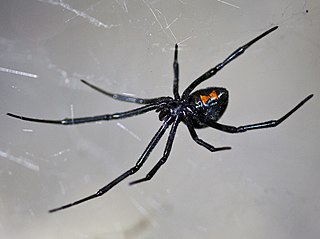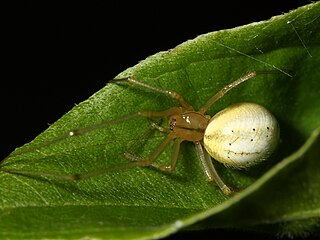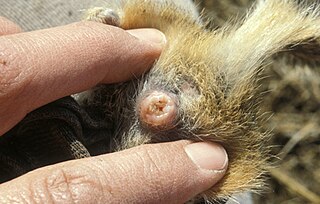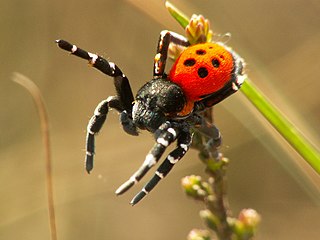
Latrodectus is a broadly distributed genus of spiders with several species that are commonly known as the true widows. This group is composed of those often loosely called black widow spiders, brown widow spiders, and similar spiders. However, such general "common names" are of limited use, as the diversity of species is much greater. A member of the family Theridiidae, this genus contains 34 species, which include several North American "black widows". Besides these, North America also has the red widow Latrodectus bishopi and the brown widow Latrodectus geometricus, which, in addition to North America, has a much wider geographic distribution. Elsewhere, others include the European black widow, the Australian redback black widow and the closely-related New Zealand katipō, several different species in Southern Africa that can be called Button spiders, and the South American black-widow spiders. Species vary widely in size. In most cases, the females are dark-coloured, but some may have lighter or even reddish bodies. Many can have red, white or brown markings on the upper-side (dorsal) of the abdomen. Some can be readily identifiable by reddish markings on the central underside (ventral) abdomen, which are often hourglass-shaped.

Theridiidae, also known as the tangle-web spiders, cobweb spiders and comb-footed spiders, is a large family of araneomorph spiders first described by Carl Jakob Sundevall in 1833. This diverse, globally distributed family includes over 3,000 species in 124 genera, and is the most common arthropod found in human dwellings throughout the world.

Argiope bruennichi is a species of orb-web spider distributed throughout central Europe, northern Europe, north Africa, parts of Asia, and the Azores archipelago. Like many other members of the genus Argiope, it shows striking yellow and black markings on its abdomen.

Latrodectus hesperus, the western black widow spider or western widow, is a venomous spider species found in western regions of North America. The female's body is 14–16 mm in length and is black, often with an hourglass-shaped red mark on the lower abdomen. This "hourglass" mark can be yellow, and on rare occasions, white. The male of the species is around half this length and generally a tan color with lighter striping on the abdomen. The population was previously described as a subspecies of Latrodectus mactans and it is closely related to the northern species Latrodectus variolus. The species, as with others of the genus, build irregular or "messy" webs: unlike the spiral webs or the tunnel-shaped webs of other spiders, the strands of a Latrodectus web have no apparent organization.
Tidarren is a genus of tangle-web spiders first described by Ralph Vary Chamberlin & Wilton Ivie in 1934.
Tidarren sisyphoides is a spider of the family Theridiidae.

Nephilinae is a spider subfamily of the family Araneidae with seven genera. The various genera in Nephilinae were formerly grouped in the family Nephilidae, and before that in the Tetragnathidae and in the Araneidae. All nephiline genera partially renew their webs. Spiders in the subfamily Nephilinae are commonly referred to as golden orb-weavers.

Spider cannibalism is the act of a spider consuming all or part of another individual of the same species as food. In the majority of cases a female spider kills and eats a male before, during, or after copulation. Cases in which males eat females are rare.

Sexual cannibalism is when an animal, usually the female, cannibalizes its mate prior to, during, or after copulation. It is a trait observed in many arachnid orders and several insect orders. Several hypotheses to explain this seemingly paradoxical behavior have been proposed. The adaptive foraging hypothesis, aggressive spillover hypothesis and mistaken identity hypothesis are among the proposed hypotheses to explain how sexual cannibalism evolved. This behavior is believed to have evolved as a manifestation of sexual conflict, occurring when the reproductive interests of males and females differ. In many species that exhibit sexual cannibalism, the female consumes the male upon detection. Females of cannibalistic species are generally hostile and unwilling to mate; thus many males of these species have developed adaptive behaviors to counteract female aggression.

A mating plug, also known as a copulation plug, sperm plug, vaginal plug, or sphragis, is gelatinous secretion used in the mating of some species. It is deposited by a male into a female genital tract, such as the vagina, and later hardens into a plug or glues the tract together. While females can expel the plugs afterwards, the male's sperm still gets a time advantage in getting to the egg, which is often the deciding factor in fertilization.
Monogyny is a specialised mating system in which a male can only mate with one female throughout his lifetime but the female may mate with more than one male. In this system the males generally provide no paternal care. In many spider species that are monogynous, the males have two copulatory organs, which allows them to mate a maximum of twice throughout their lifetime. As is commonly seen in honeybees, ants and certain spider species, a male may put all his energy into a single copulation, knowing that this will lower his overall fitness. During copulation monogynous males have adapted to cause self genital damage or even death to increase their chances of paternity.

The six-spotted fishing spider is an arachnid from the nursery web spider family Pisauridae. This species is from the genus Dolomedes, or the fishing spiders. Found in wetland habitats throughout North America, these spiders are usually seen scampering along the surface of ponds and other bodies of water. They are also referred to as dock spiders because they can sometimes be witnessed quickly vanishing through the cracks of boat docks. D. triton gets its scientific name from the Greek mythological god Triton, who is the messenger of the big sea and the son of Poseidon.

Spiders are air-breathing arthropods that have eight legs, chelicerae with fangs generally able to inject venom, and spinnerets that extrude silk. They are the largest order of arachnids and rank seventh in total species diversity among all orders of organisms. Spiders are found worldwide on every continent except for Antarctica, and have become established in nearly every land habitat. As of August 2021, 50,266 spider species in 132 families have been recorded by taxonomists. However, there has been dissension within the scientific community as to how all these families should be classified, as evidenced by the over 20 different classifications that have been proposed since 1900.

Sexual selection in spiders shows how sexual selection explains the evolution of phenotypic traits in spiders. Male spiders have many complex courtship rituals and have to avoid being eaten by the females, with the males of most species survive a few matings, and having short life spans.

Herennia multipuncta, commonly known as the ornamental tree trunk spider, is a species of spider in the family Araneidae native to Asia. It exhibits sexual dimorphism, the female being much larger than the male. It weaves a small web on the trunk of a tree or the wall of a building and is well camouflaged by its dappled colouration.

Tigrosa helluo is a species of spider belonging to the family Lycosidae, also known as wolf spiders. T. helluo was formerly known as Hogna helluo before differences between dorsal color patterns, habitat preferences, body structures, etc. were discovered. The species is native to the United States, Canada, and Mexico. It can be found across the eastern half of the United States, primarily in the Northeast and New England, and as far west as Nebraska and Kansas. T. helluo can be found in diverse habitats including woods, marshes, fields, and riparian areas. Typically, members of this species prefer to live in wetter areas as opposed to dry environments. Males tend to live for around a year and females will live for close to two years.

The two palpal bulbs – also known as palpal organs and genital bulbs – are the copulatory organs of a male spider. They are borne on the last segment of the pedipalps, giving the spider an appearance often described as like wearing boxing gloves. The palpal bulb does not actually produce sperm, being used only to transfer it to the female. Palpal bulbs are only fully developed in adult male spiders and are not completely visible until after the final moult. In the majority of species of spider, the bulbs have complex shapes and are important in identification.
Agelenopsis pennsylvanica, commonly known as the Pennsylvania funnel-web spider or the Pennsylvania grass spider, is a species of spider in the family Agelenidae. The common name comes from the place that it was described, Pennsylvania, and the funnel shape of its web. Its closest relative is Agelenopsis potteri.

Leucauge mariana is a long-jawed orb weaver spider, native to Central America and South America. Its web building and sexual behavior have been studied extensively. Males perform several kinds of courtship behavior to induce females to copulate and to use their sperm.

Larinia jeskovi is a species of the family of orb weaver spiders and a part of the genus Larinia. It is distributed throughout the Americas, Africa, Australia, Europe, and Asia and commonly found in wet climes such as marshes, bogs, and rainforests. Larinia jeskovi have yellow bodies with stripes and range from 5.13-8.70 millimeters in body length. They build their webs on plants with a small height above small bodies of waters or wetlands. After sunset and before sunrise are the typical times they hunt and build their web. Males usually occupy a female's web instead of making their own. The mating behavior is noteworthy as male spiders often mutilate external female genitalia to reduce sperm competition while female spiders resort to sexual cannibalism to counter such mechanisms. The males also follow an elaborate courtship ritual to attract the female. The bite of Larinia jeskovi is not known to be of harm to humans.















